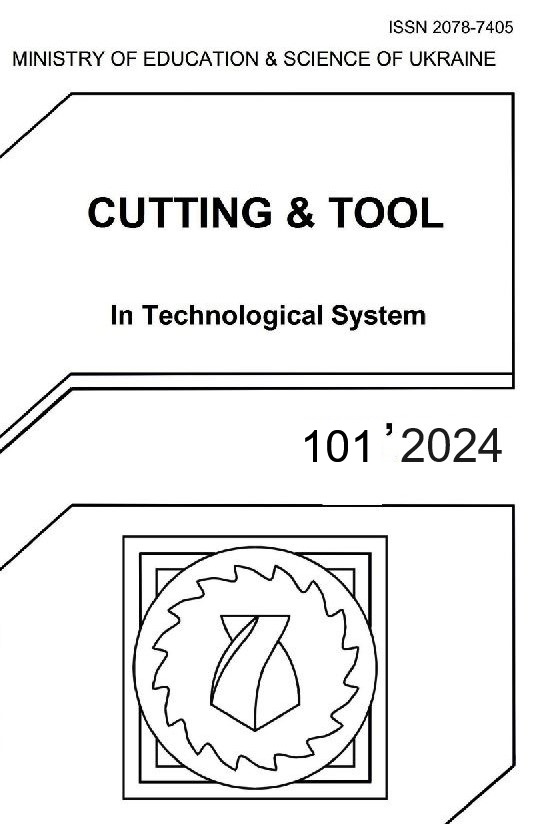CORRELATION ANALYSIS BETWEEN COMPONENTS OF FORCE AND VIBRATION IN TURNING OF 11SMN30 STEEL
DOI:
https://doi.org/10.20998/2078-7405.2024.101.04Keywords:
turning operation, cutting forces & vibrations, correlation, analysis of varianceAbstract
Workability of material is defined as the ease of operating on it. 11SMn30 is widely used material in automobile manufacturing industries. Cutting forces have been shown to be the most effective measure for understanding metal machining processes. The forces which helps in performing machining operation also affects the cutting tool, in terms of deformation, bend, wear, which leads to the vibration in the machining system, This article aims to study the correlation between feed, components of cutting forces and components of vibration in turning of 11SMn30 steel grade using dynamometer and MPU6050 sensor.
References
Joy, B. & Kumar, P. M. Optimization in Turning of 11sMn30 Through Process Capability Index. Materials Today: Proceedings vol. 11 www.sciencedirect.com (2019).
Varghese, L. Multi-Objective Optimization of Machining Parameters during Dry Turning of 11SMn30 Free Cutting Steel Using Grey Relational Analysis. www.sciencedirect.comwww.materialstoday.com/proceedings 2214-7853 (2017).
Sharma, V., Kumar, P. & Misra, J. P. Cutting force predictive modelling of hard turning operation using fuzzy logic. in Materials Today: Proceedings vol. 26 740–744 (Elsevier Ltd, 2019).
Tansel, I. N. et al. Tool Wear Estimation in Micro-Machining. Part I: Tool Usage-Cutting Force Relationship. International Journal of Machine Tools & Manufacture vol. 40 (2000).
Şeker, U., Kurt, A. & Çiftçi, I. The effect of feed rate on the cutting forces when machining with linear motion. J Mater Process Technol 146, 403–407 (2004).
Laghari, R. A., Li, J. & Mia, M. Effects of turning parameters and parametric optimization of the cutting forces in machining SiCp/Al 45 wt% composite. Metals (Basel) 10, 1–22 (2020).
Yu, Q., Li, S., Zhang, X. & Shao, M. Experimental study on correlation between turning temperature rise and turning vibration in dry turning on aluminum alloy. International Journal of Advanced Manufacturing Technology 103, 453–469 (2019).
Aslan, A. Optimization and analysis of process parameters for flank wear, cutting forces and vibration in turning of AISI 5140: A comprehensive study. Measurement (Lond) 163, (2020).
Wu, Y., Song, Q., Liu, Z. & Wang, B. Stability of turning process with a distributed cutting force model. International Journal of Advanced Manufacturing Technology 102, 1215–1225 (2019).
Zerti, O., Yallese, M. A., Khettabi, R., Chaoui, K. & Mabrouki, T. Design optimization for minimum technological parameters when dry turning of AISI D3 steel using Taguchi method. International Journal of Advanced Manufacturing Technology 89, 1915–1934 (2017).
Xie, H. & Wang, Z. Study of cutting forces using FE, ANOVA, and BPNN in elliptical vibration cutting of titanium alloy Ti-6Al-4V. International Journal of Advanced Manufacturing Technology 105, 5105–5120 (2019).
Huang, W. T. & Wu, Z. X. Research on optimization of cutting force in AISI D2 hardened steel ultrasonic vibration-assisted turning. in Journal of Physics: Conference Series vol. 2345 (Institute of Physics, 2022).
Rama Kotaiah, K., Srinivas, J. & Sekar, M. Force Feed Effects on Process Stability in Turning. Bangladesh J. Sci. Ind. Res vol. 45 www.banglajol.info (2010).
Kagade, V. R. & Deshmukh, R. R. Experimental investigation of turning operation using carbide inserts. International Journal of Applied Research in Mechanical Engineering 87–89 (2011) doi:10.47893/IJARME.2011.1017.
Kumar, S., Gupta, M. & Satsangi, P. S. Multiple-response optimization of cutting forces in turning of UD-GFRP composite using Distance-Based Pareto Genetic Algorithm approach. Engineering Science and Technology, an International Journal 18, 680–695 (2015).
Al-Ahmari, A. M. A. Predictive machinability models for a selected hard material in turning operations. J Mater Process Technol 190, 305–311 (2007).
Jang, D. Y., Choi, Y. G., Kim, H. G. & Hsiao, A. Study of the correlation between surface roughness and cutting vibrations to develop an on-line roughness measuring technique in hard turning. Int. J. Mach. Tools Manuf. 36, 453–464 (1996).
EU Steel and Alloy Grades Number. Preprint at http://www.steelnumber.com/en/ (2024).
Ridwan, F. & Xu, X. Advanced CNC system with in-process feed-rate optimisation. Robot Comput. Integr. Manuf. 29, 12–20 (2013).
Walter. Preprint at https://www.walter-tools.com/en-us (2024).
Cameron, N. ESP32 Microcontroller BT ‒ ESP32 Formats and Communication: Application of Communication Protocols with ESP32 Microcontroller. 1–54 (2023).
Cameron, Neil. ESP32 formats and communication : application of communication protocols with ESP32 microcontroller. 646 (2023).
Rizal, M., Ghani, J. A. & Mubarak, A. Z. Design and Development of a Tri-Axial Turning Dynamometer Utilizing Cross-Beam Type Force Transducer for Fine-Turning Cutting Force Measurement. Sensors 22, (2022).
Downloads
Published
Issue
Section
License
Copyright Notice
Authors who publish with this Collection agree to the following terms:
1. Authors retain copyright and grant the Collection right of first publication with the work simultaneously licensed under a Creative Commons Attribution License that allows others to share the work with an acknowledgement of the work's authorship and initial publication in this Collection.
2. Authors are able to enter into separate, additional contractual arrangements for the non-exclusive distribution of the Collection's published version of the work (e.g., post it to an institutional repository or publish it in a book), with an acknowledgement of its initial publication in this Collection.
3. Authors are permitted and encouraged to post their work online (e.g., in institutional repositories or on their website) prior to and during the submission process, as it can lead to productive exchanges, as well as earlier and greater citation of published work.

